Why do so many of us get so fat? the answer appears obvious. “The
fundamental cause of obesity and overweight,” the World Health
Organization says, “is an energy imbalance between calories consumed and
calories expended.” Put simply, we either eat too much or are too
sedentary, or both. By this logic, any excess of calories—whether from
protein, carbohydrate or fat (the three main components, or
“macronutrients,” in food)—will inevitably pack on the pounds. So the
solution is also obvious: eat less, exercise more.
The reason to question this conventional thinking is equally
self-evident.
The eat less/move more prescription has been widely
disseminated for 40 years, and yet the prevalence of obesity, or the
accumulation of unhealthy amounts of body fat, has climbed to
unprecedented levels. Today more than a third of Americans are
considered obese—more than twice the proportion of 40 years ago.
Worldwide, more than half a billion people are now obese. Besides getting fatter, we are also developing more metabolic disorders,
such as type 2 diabetes, which is marked by hormonal abnormalities in
the processing and storage of nutrients and is far more common in obese
individuals than in lean ones.
The dissonance of an ever worsening problem despite a seemingly
well-accepted solution suggests two possibilities. One, our
understanding of why people get fat is correct, but those who are
obese—for genetic, environmental or behavioral reasons—are unable or
unwilling to heal themselves. Two, our understanding is wrong and hence
so is the ubiquitous advice about how to make things better.
If the second option is true, then maybe what makes us fat is not an
energy imbalance but something more akin to a hormonal defect, an idea
embraced by European researchers prior to World War II. If so, the prime
suspect or environmental trigger of this defect would be the quantity
and quality of the carbohydrates we consume. Under this scenario,
one fundamental error we have made in our thinking
about obesity is to assume that the energy content of foods—whether
avocado, steak, bread or soda—is what makes them fattening, not the
effects that these foods, carbohydrates in particular, have on the
hormones that regulate fat accumulation.
The research
To test this last
hypothesis a new research program has been planned by Gary Taubes and The Nutrition
Science Institute and described in the
Scientific American special food issue. This study will entail having subjects consume 80%
of their calories as fat, and 5% as carbohydrates, in an effort to
determine if consuming calories as fat results in better insulin control
and in weight loss.
The Hormone hypothesis
To understand what makes the hormone hypothesis of obesity so
intriguing, it helps to grasp where the energy-balance hypothesis falls
short. The idea that obesity is caused by consuming more calories than
we expend supposedly stems from the first law of thermodynamics, which
merely states that energy can neither be created nor destroyed. As
applied to biology, it means that energy consumed by an organism has to
be either converted to a useful form (metabolized), excreted or stored.
Thus, if we take in more calories than we expend or excrete, the excess
has to be stored, which means that we get fatter and heavier. So far, so
obvious. But this law tells us nothing about why we take in more
calories than we expend, nor does it tell us why the excess gets stored
as fat. And it is these “why” questions that need to be answered.
Specifically, why do fat cells accumulate fat molecules to excess? This is a biological question, not a physics one. Why are those fat molecules not
metabolized instead to generate energy or heat? And why do fat cells
take up excessive fat in some areas of the body but not others? Saying
that they do so because excess calories are consumed is not a meaningful
answer.
Answering these questions leads to consideration of the
role that hormones—insulin, in particular—play in stimulating fat
accumulation in different cells. Insulin is secreted in response to a
type of carbohydrate called glucose. When the amount of glucose rises in
the blood—as happens after eating a carbohydrate-rich meal—the pancreas
secretes more insulin, which works to keep the blood glucose level from
getting dangerously high. Insulin tells muscle, organ and even fat
cells to take up the glucose and use it for fuel. It also tells fat
cells to store fat—including fat from the meal—for later use. As long as
insulin levels remain high, fat cells retain fat, and the other cells
preferentially burn glucose (and not fat) for energy. The main dietary sources of glucose are starches, grains and sugars. (In
the absence of carbohydrates, the liver will synthesize glucose from
protein.) The more easily digestible the carbohydrates, the greater and
quicker the rise in blood glucose. (Fiber and fat in foods slow the
process.) Thus,
a diet rich in refined grains and starches will prompt
greater insulin secretion than a diet that is not. Sugars—such as
sucrose and high-fructose corn syrup—may play a key role because they
also contain significant amounts of a carbohydrate called fructose,
which is metabolized mostly by liver cells.
The author's conclusion
The result, according to the hormone hypothesis, is an ever greater
proportion of the day that insulin in the blood is elevated, causing fat
to accumulate in fat cells rather than being used to fuel the body. As
little as 10 or 20 calories stored as excess fat each day can lead over
decades to obesity.
The hormone hypothesis suggests that the only
way to prevent this downward spiral from happening, and to reverse it
when it does, is to avoid the sugars and carbohydrates that work to
raise insulin levels. Then the body will naturally tap its store of fat
to burn for fuel. The switch from carbohydrate burning to fat burning,
so the logic goes, might occur even if the total number of calories
consumed remains unchanged. Cells burn the fat because hormones are
effectively telling them to do so; the body's energy expenditure
increases as a result.
To lose excess body fat, according to this view,
carbohydrates must be restricted and replaced, ideally with fat, which
does not stimulate insulin secretion. This alternative hypothesis of obesity implies that the ongoing
worldwide epidemics of obesity and type 2 diabetes (which stems to great
extent from insulin resistance) are largely driven by the grains and
sugars in our diets. It also implies that the first step in solving
these crises is to avoid sugars and limit consumption of starchy
vegetables and grains, not worrying about how much we are eating and
exercising.
A different point of view
The right nutrition question is “What should we eat to have the longest,
healthiest life?” Instead, author Gary Taubes is asking “What should we
eat to lose weight?” There are many ways to lose weight, and still be
sick and die.
Taubes’s study isn’t even designed to measure health or
longevity. So when his study shows that one can lose weight with an
low-carb diet, he will argue that obese people should go on a low-carb
diet because obesity is correlated with many fatal diseases. However, a
low-carb diet changes that correlation. There are plenty of thin people
who die of heart disease.
According to John Tanner, -Ph.D. Director, NuSci, The Nutrition Science Foundation- Gary Tauber's study will most likely result in a confusing and misleading result because it is asking the wrong question. Instead, the right premises will lead to a clear answer. In his intense study of research results Tanner says he found a consistent pattern emerging:
a whole-food plant-based diet low in fat and high in carbs results in
the total elimination of heart disease and dramatic reduction and/or
reversal of type 2 diabetes, stroke, high blood pressure, cancer, and
about 30 other diseases. And as a nice side effect, obese and overweight
people lose weight, often in a dramatic fashion.
What's your priority? What is worth the price of a diet: your look or your health? Re-thinking your goals will help you stay committed to a healthy diet...
Sources: http://www.scientificamerican.com/,
http://www.nusci.org/


























.jpg)


